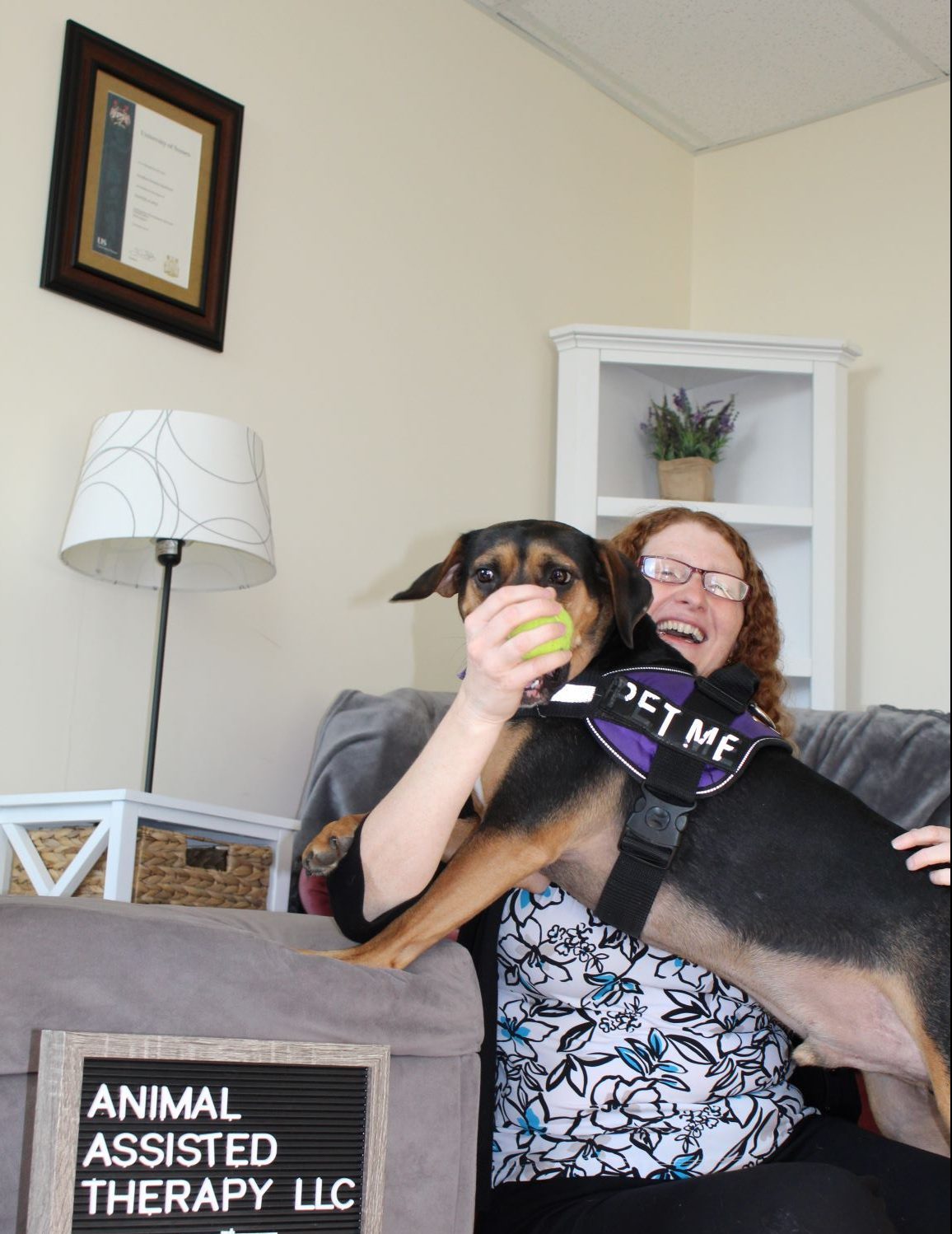Q&A on Animal-Assisted Therapy

But first, a message: Graduating Class of 2020, you’ve worked so hard this year. You’ve overcome challenges that no class before you has faced and you are an absolute inspiration. Congratulations on all your achievements!
College students everywhere are wrapping up end-of-semester projects and this has led to a number of unusual phone calls for me and Benji. I love getting these calls! Future health professionals interested in joining our special niche of healthcare: animal-assisted therapy (AAT). Benji is taking a break from his blogging gig today, and passing the keyboard to me, Annalisa, so I can share one of these Q&A sessions.
Meet Mandy Winberg, a nursing student at St. Luke’s. She is taking a Mental Health Nursing course and wants to better understand animal-assisted therapy. She is curious to learn about its impact on patients/clients and how, exactly, AAT helps people.
Mandy: What is animal-assisted therapy?
Annalisa: Animal-assisted therapy is a type of mental health treatment that intentionally includes a trained animal in the therapeutic process.
Q: How does animal-assisted therapy generally work?
A: In the field of psychotherapy AAT is not considered it’s own theoretical orientation, like CBT or Gestalt therapy, but rather it’s a set of practices that a therapist incorporates into their work. I find it fits well with my Narrative approach which uses creativity and the power of language to help people heal. I watch for moments when my client connects with Benji and then invite them to narrate the interaction–to tell the story as it happens. As the client names physical and emotional feelings that Benji elicits, they gain more insight into their mind/body connection. This skill is so good for recognizing and reducing symptoms of both anxiety and depression!
Q: What type of patients/clients would benefit from AAT?
A: In my experience, people who have endured trauma, anxiety, depression, and substance use disorders seem to benefit from Benji’s presence in the therapy room. He helps people reconnect when they’re feeling “shut off” or “numb”; he helps traumatized people enjoy physical touch again (something a human therapist could never do directly); he encourages depressed clients to go outside and perform self-care activities like walking, playing, and drinking water; he models self-care for anxious clients too, by inviting us to live in the moment with him while he’s relaxing, napping, and being petted or groomed.
Q: How do the patients/clients interact with him?
A: Benji is really good at teaching people to recognize the physical manifestations of mental health conditions. For example, when a person’s symptoms of anxiety begin to elevate, he perches on their feet and makes eye contact with me. I can’t read his mind or my client’s, so I typically just ask, “what is Benji trying to tell us?” or “what is happening in your body right now that he may be sensing?” and they tell me “my stomach hurts, I’m nauseated, my muscles are tense, etc.” It’s important for the therapist to be flexible with the goals and direction of the therapy and to be attentive to what’s happening in the room, what Yalom calls the “here-and-now”. Benji and the client could have a soothing session of petting and sitting in silence–both healing activities–but what shifts it from a bonding session with a pet to actual psychotherapy? The therapist! We must be willing to speak directly about what is happening and process how it feels and what it means with the client.
Q. Would people with mental illness benefit from this type of therapy from your own experience?
A. Yes!
Q: Have you seen a change among your clients after AAT was introduced into their lives?
A: Absolutely, especially for drug and alcohol treatment! I’ve noticed that clients who have the opportunity to bond with Benji during their intake are more likely to return for their next session. One of the biggest barriers to addiction treatment is multiple no-shows and cancellations that lead to discharge AMA. Clients who bond with Benji are quicker to create the therapeutic alliance with me, as they follow Benji’s lead in trusting me. We know from research that the therapeutic alliance is one of the most important factors in counseling outcomes, so this is a true gift for me and the client.
Q: Can you give an example of how clients change after experiencing AAT?
A: I have several clients that struggled to open up at first, but then with a dog in their lap, or when walking the dog outside, began sharing more deeply. Therapy can be a scary experience for many people as we are asked to be vulnerable and sometimes painfully honest. Having a non-judgmental pup looking on lovingly during those vulnerable moments is incredibly healing. The rhythmic, meditative act of petting or brushing the animal while talking creates opportunities to say more and go deeper than a client otherwise would. (Compare it to kinetic learners in school who do better with a fidget spinner in their hands.) Benji also creates comic relief and the occasional welcome distraction during difficult group sessions.
Q: Where do you help your clients? (i.e. in your office, at their home, hospitals, etc.)
A: Benji and I work from my office, which is located in Pottstown, PA. It has close proximity to a trail where we can walk and use the healing power of nature, as well. Therapy animals that are registered to enter hospitals and schools have undergone a different set of training than Benji has. I’d like Benji to complete that training, but unfortunately he doesn’t have the temperament for it. He is a cheerful, playful, hands-on (or would that be paws-on) kind of dog, whereas the dogs that enter hospitals have to be super calm and focused, able to ignore big, noisy machines that may be moving around the hallways. I use this limitation as a teaching opportunity with my clients, explaining that Benji was an average student in his training but still found a great job that suits his temperament. People always take heart when I share his story!
I love talking to interested students, clinicians, and prospective clients. Feel free to contact me at [email protected] if you have questions of your own.
Best of luck in your program, Mandy!
